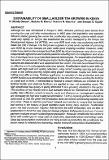| dc.description.abstract | Although tea was introduced in Kenya in 1903, Africans (natives) were barred from growing the crop until after independence in 1963 when the legislation was repealed. Africans started growing tea under the smallholder tea growing scheme which developed very rapidly. In Kenya, the smallholder tea sector, managed by the Kenya Tea Development Agency Ltd (KTDA), own over 80% land under tea producing over 60% made tea (mt) in Kenya. The Kenya tea is grown in prime lands capable of producing over 6000 kg mt per hectare per year under good cropping weather. However, smallholder teas yield on the average less than 2000 kg mt per hectare per year due to use of inappropriate agronomic and cultural practices resulting from low adaptation and adoption of developed and recommended research technologies. For sustainable smallholder tea sector, it is necessary that tea production technologies developed through extensive research are disseminated and adopted in the tea sector. This can be achieved through an effective and knowledgeable extension service. Smallholders need to plant elite varieties with high yield and quality potentials using correct planting spacing and should prune at the correct pruning height using proper implements. Gappy tea fields need infilling soon after pruning. Fertilizer application is mandatory in tea production and use of NPK fertilizers is recommended in Kenya. KTDA should continue availing the fertilizer on credit and on time. A mechanism is needed to ensure farmers are enrolled for the fertilizer facility and obtained fertilizers are applied on tea, not competing crops. The high smallholder tea quality is partly attributed to fine plucking standard in the sector. The plucking of two leaves and a bud standard should be maintained to sustain the quality. Also effective control of weeds, pests and diseases or management systems are necessary for high and quality tea production. Factory capacity problems should be addressed so that the green leaf production does not exceed processing capacity and vice versa. There is need for good road network and vehicles to ensure that harvested leaves arrive in the factory in good condition even during rainy seasons. Sustainable green tea leaf production requires that farmers are paid adequately and on time to enable them to tend the crop. Regular reviews of green leaf payment and use of correct payment modules ensure sustaining tea production. However, smallholder tea sector is faced with challenges in rising costs of production, especially labour and energy costs. Since tea consumption world wide is not rising as fast as production, the smallholder tea sector needs to intensify tea marketing, market research and product diversification. | en_US |

